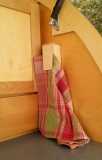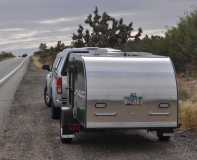The galley is looking great now, nice attention to detail & space utilization. A CNC is good, but a plunge router with a reverse flush-cut bit will get the job done. Only problem is that making a pattern can be a little time-consuming. Once the pattern is finished, an unlimited number of parts can be made with good precision. Not great for a one-off part, but it works.
Tom & Shelly's build
Re: Tom & Shelly's build
Here's an idea for a towel holder (I only steal the best ideas). Drill a block of wood on an angle with a 1" bit, drop in a 1" marble & cover the cut. Lets you slide a dish towel up in place, but to pull it out, a tug to the side is what gets the towel out. It won't drop out of the bottom, as the marble holds it tight. If the towel falls out, you have other things to look at!

The galley is looking great now, nice attention to detail & space utilization. A CNC is good, but a plunge router with a reverse flush-cut bit will get the job done. Only problem is that making a pattern can be a little time-consuming. Once the pattern is finished, an unlimited number of parts can be made with good precision. Not great for a one-off part, but it works.
The galley is looking great now, nice attention to detail & space utilization. A CNC is good, but a plunge router with a reverse flush-cut bit will get the job done. Only problem is that making a pattern can be a little time-consuming. Once the pattern is finished, an unlimited number of parts can be made with good precision. Not great for a one-off part, but it works.
Build log: viewtopic.php?f=50&t=60248
The time you spend planning is more important than the time you spend building.........

The time you spend planning is more important than the time you spend building.........
-

noseoil - 1000 Club

- Posts: 1822
- Images: 670
- Joined: Sun Apr 27, 2014 8:46 am
- Location: Raton, New Mexico, living the good life!
Re: Tom & Shelly's build
noseoil wrote:Here's an idea for a towel holder (I only steal the best ideas).
Thank you for the idea Tim.
Tom
- Tom&Shelly
- Palladium Donating Member
- Posts: 2464
- Images: 2282
- Joined: Tue Sep 05, 2017 3:27 pm
- Location: New Mexico







